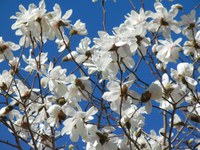Dakota Gardener: The steel magnolia for the Dakotas
(Click an image below to view a high-resolution image that can be downloaded)
By Tom Kalb, Horticulturist
NDSU Extension
Magnolia trees are cherished for their showy, fragrant blossoms in early spring. Common in southern landscapes, magnolias are rarely grown in the Dakotas because their blossoms are sensitive to spring frosts.
The phrase “steel magnolia” is used to describe a woman who is both lovely and shows toughness under adversity. Lovely and tough—that’s exactly the type of magnolia tree we need in the Dakotas.
Get to know our steel magnolia, Spring Welcome®. Developed by North Dakota State University, this small tree should be your first consideration when selecting a magnolia.
Spring Welcome® magnolia is absolutely lovely. Its light-pink buds unfurl into large, fragrant, pristine-white flowers. It has attractive, dark-green, leathery leaves that turn greenish yellow to bronze in autumn.
Spring Welcome® is a dazzler in spring. Its flowers open before its leaves emerge, and these blooms are big and showy. This tree is often used as a focal point in flower plantings, foundation plantings or near terraces and patios.
Spring Welcome® has stunning looks, but the true beauty of Spring Welcome® lies within its toughness.
The cold hardiness of its flower buds is vastly superior to the cold hardiness of any other cultivar’s flower buds. The buds of Spring Welcome® are known to tolerate spring frosts and still bloom profusely.
Spring Welcome® has proven to be winter hardy in USDA hardiness zone 4 for the past 20 years, even after winter temperatures of minus 40 degrees Fahrenheit. Spring Welcome® has outperformed other Loebner magnolia hybrids tested in zone 4. This zone includes all of North Dakota except for along the Canadian border.
For those of you living near Canada, the cold hardiness of Spring Welcome® makes it clearly the best and perhaps your only option.
Spring Welcome® resists pests and diseases and is rarely damaged by deer or rabbits.
Developed in North Dakota, this magnolia tolerates our prairie soils much better than most magnolias.
The tree has a vigorous habit and blooms at a young age. It grows in an oval to rounded form to about 15 feet high and 10 to 15 feet wide. It can be single or multi-trunked.
The greatest risk when growing any magnolia is that its flowers freeze to death. Our primary goal must be to delay the opening of the blooms as long as possible to avoid their exposure to freezing weather in spring.
To put it another way, we want to keep the planting site cool to keep the tree dormant and safe from killing frosts for as long as possible in the spring.
Start by selecting a suitable planting site. Magnolias prefer a sunny or partly sunny location. An east-facing site is preferred because it receives the cool morning sun. This allows the tree to stay dormant longer. South- and west-facing sites are riskier because warm afternoon temperatures may trigger the magnolia to wake up prematurely.
Once the site is selected, get a bale or two of sphagnum peat moss to create a 6-inch-high bed for the tree. Mix this mulch into the native soil before planting. A moss-enriched bed will improve drainage and add acidity to the soil, which every magnolia tree will appreciate.
It is very important to add shredded bark mulch under the tree. This mulch will insulate the soil, preventing the soil from warming up quickly in early spring. Remember, we want to keep the site cool in spring.
I invite you to grow Spring Welcome®, the steel magnolia for the Dakotas. To order one of these trees for planting next spring, search online or contact your local nursery.
For more information about gardening, contact your local NDSU Extension agent. Find the Extension office for your county at www.ndsu.edu/agriculture/extension/county-extension-offices.
NDSU Agriculture Communication – October 8, 2025
Source: Tom Kalb, 701-877-2585, tom.kalb@ndsu.edu
Editor: Kelli Anderson, 701-231-6136, kelli.c.anderson@ndsu.edu




